Click here to follow Screen Digital on YouTube and stay updated with the latest from the world of cinema.
Lata Mangeshkar: The ‘naughty’ girl who grew up in a day after father’s death, refused to sing with Mohammed Rafi over royalty issues
On Lata Mangeshkar's death anniversary, we revisit her illustrious career and life. Lata started working at the age of 13 to take care of her family after her father's sudden demise. She went on to become the 'Nightingale of India' and sang over 20,000 songs.
 Music was life for Lata Mangeshkar. She never compromised on her work. (Express archive photo)
Music was life for Lata Mangeshkar. She never compromised on her work. (Express archive photo) One does not need to be a music aficionado to appreciate the voice of Lata Mangeshkar. It is something that cannot be ignored or missed, her voice is perhaps part of everyday lives of Indians, comforting and rousing in equal measure. Be it the first love or first heartbreak, unknowingly Lata Didi, as she was fondly called, became our companion in life through her melodious voice. Every word that came out of her mouth transcended a deep emotion. She could emote love (‘Lag Ja Gale’) with as much aplomb as she emoted pain (‘Ajeeb Daastaan Hai Yeh’). When she sang ‘O Pallanhare’ or ‘Allah tero naam’, the divinity of her voice connected the listeners to the almighty.
“When you are talking about Michelangelo, Beethoven or Shakespeare, the name says it all. Lata Mangeshkar’s greatness is her name itself. There is no other word that can encapsulate her,” Javed Akhtar had once said about her. Lyricist Gulzar too, prophetically made her announce to the world, ‘Meri awaaz hi pehchaan hai’.
Born on September 28, 1929, in Solapur, Maharashtra, in a Marathi family, to melodious parents, father Deenanath Mangeshkar and mother Shudhamati, Lata was the eldest of five — sisters Meena Mangeshkar, Asha Bhosle, Usha Mangeshkar, and brother Hridayanath Mangeshkar. In her childhood, she was nothing like her popular public image — serious, quiet and no-nonsense woman. Instead, she was quite mischievous.
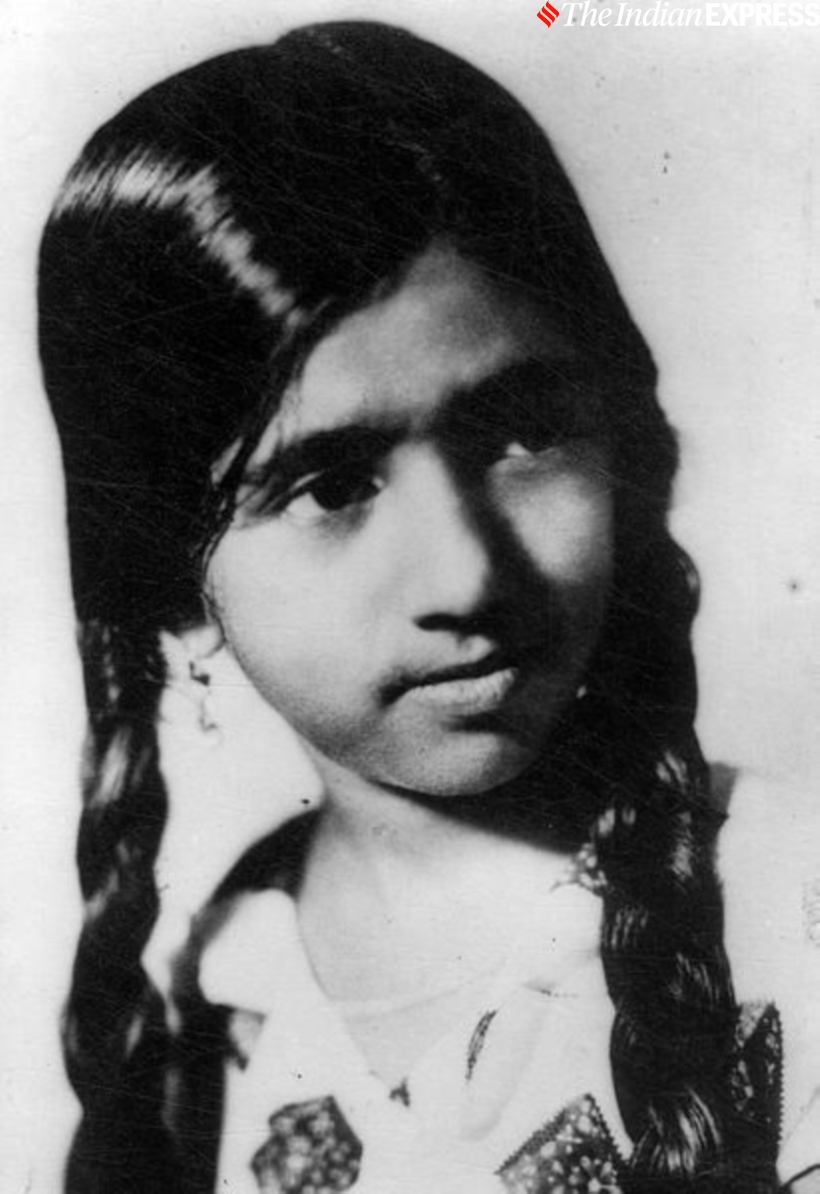 Lata Mangeshkar began her career at the age of 13. (Photo: Express Archive)
Lata Mangeshkar began her career at the age of 13. (Photo: Express Archive)
By her own confession, “I was very naughty. I used to sit in the tyre, and the girls would roll it on the road. I used to climb trees, steal guavas from neighbour’s trees and I always had a stick in my hand with which I would beat someone or the other.” Though a look from her father was enough to quieten her and her siblings, all of them used to get a good beating from their mother for their mischief. Despite her father’s reservations about them watching theatre and films, Lata was fond of watching movies and enacting them with her sister Meena, who was just a couple of years younger than her.
But since childhood, Lata had music in her. Meena had once told ABP, “I never saw her sitting in one place. She would sit in the kitchen while our mother cooked. Maa used to get annoyed and threatened to beat her if she didn’t stop singing. She used to sing with every bite of her food.” Ultimately, her father, a maestro of Marathi theatre, a Natya Sangeet musician and a Hindustani classical vocalist, noticed her singing talent when she was 5 years old and was correcting one of his students who had come home for training.
“One day, he was teaching Raag Puriya Dhanashri to a young shagird and for some reason, he left the room and Baba’s pupil continued singing. I was playing outside and could hear him. I had a feeling the boy wasn’t singing it right. So I went in and said: ‘That isn’t it. This is how it should be sung.’ And I sang the notes to him. At that moment, my father returned and heard me. He called Mai and said: ‘We have a good singer at home and never knew it,’” Lata told Nasreen Munni Kabir for her book ‘Lata Mangeshkar…In Her Own Voice’.
That was when Lata Mangeshkar became her father’s disciple. She started travelling with him for his performances but tragedy struck her family as he passed away in 1942 when she was just 13. A young Lata turned “22 from 13 in just one day.” Her sister Meena recalled, “She turned 22 in just a day. She took our responsibility. Our father died in April, and Didi started work in June. But she never let us know about her struggles.”
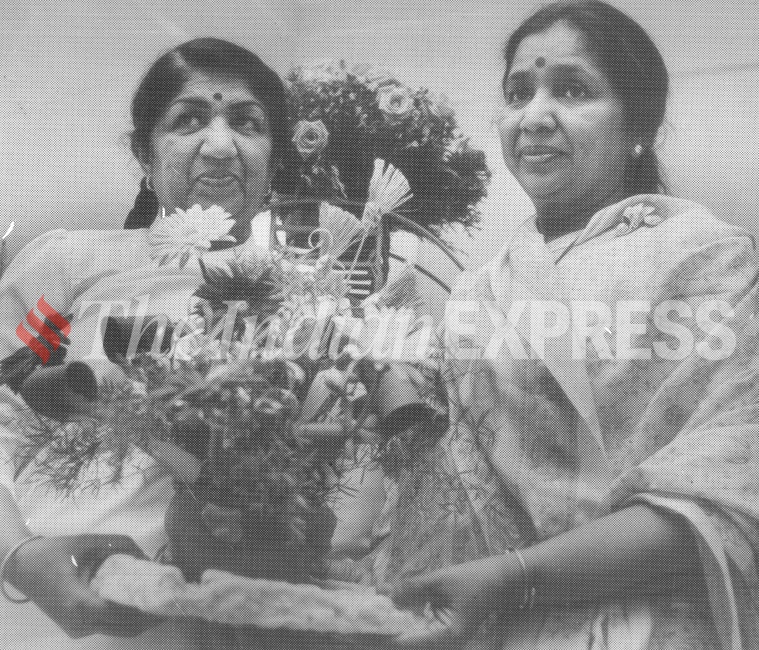 Lata Mangeshkar and Asha Bhosle. (Express archive photo)
Lata Mangeshkar and Asha Bhosle. (Express archive photo)
The financial needs of the family turned Lata into a reluctant actor. “I was ready to sing, act… so that I could provide for the family. The studio was far from the Malad station. Everyone else heading there took a tonga (horse cart), but I used to walk. I would save the money to buy vegetables on my way back. During lunch break, people went to the canteen to eat or have a cup of chai, but never me. I would starve the whole day so that there was money to run the family,” she told Javed Akhtar during an interview.
With the help of actor Master Vinayak, she found small roles for herself in Marathi films. But she hated every bit of her acting job. She once came home crying after a director cut her hair and eyebrow. She narrated, “They did my makeup and took me to the studio. When the director saw me, he said, ‘Her eyebrows are quite thick and her forehead looks small.’ I had only one thought that I have to work to help my family. He asked, ‘If we make your eyebrows thinner, will it work for you? I said, ‘chalega (it’s fine)’ They also cut my hair from the front so that my forehead looked bigger. I didn’t say anything then because I wanted payment. But after I came home, I was climbing stairs and crying. I hugged my mother and told her, ‘See, what happened to me!'” Pahili Mangalagaur (1942), Subhadra (1946), and Mandir (1948) were some of the films she acted in.
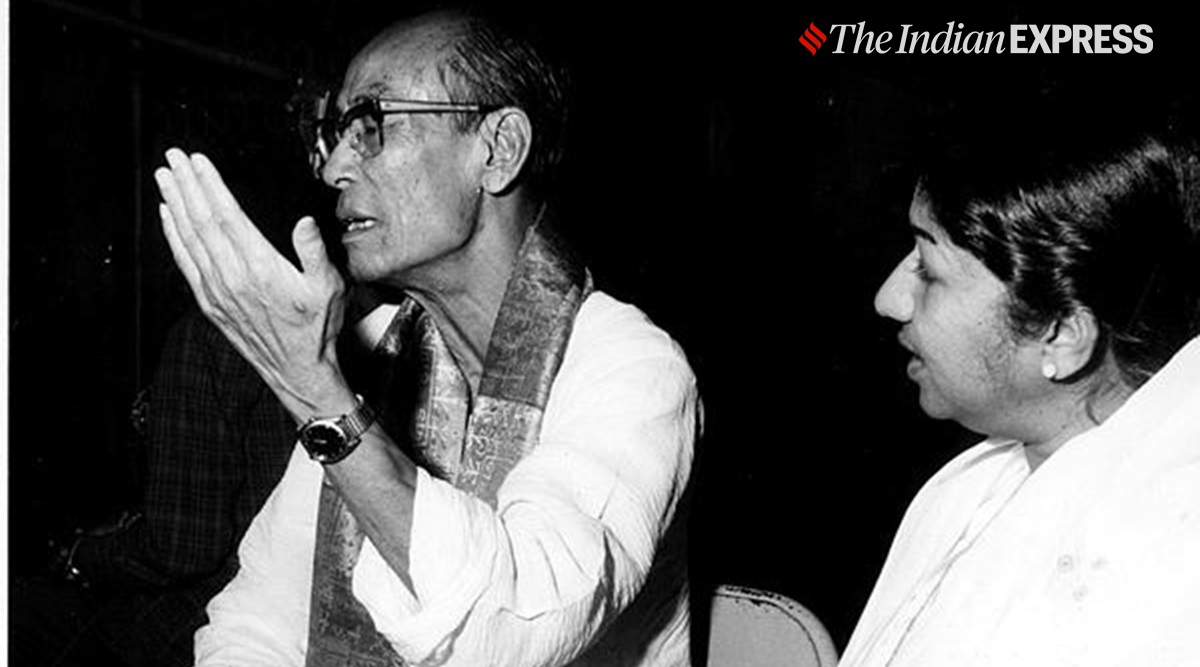 SD Burman with Lata Mangeshkar. (Photo: Express Archive)
SD Burman with Lata Mangeshkar. (Photo: Express Archive)
It was after the death of Master Vinayak in 1947 that Lata knocked on the doors of music directors for work. Though she was recommended by music directors Datta Davjekar and Vasant Desai to fellow music makers, work eluded her. In 1948, renowned composer Master Ghulam Haider, who had recognised the talent of NoorJehan, realised Lata’s potential and took her to Filmistaan Studio to meet the studio’s founder and producer, Sashadhar Mukherjee.
However, Mukherjee rejected her voice saying it was “too thin” (later, OP Nayyar said something similar about her). A hurt Haider didn’t tell Lata what Mukherjee said about her voice and took her to Bombay Talkies, where he trained her for three days and made her do playback for the 1948 film Majboor. Her songs ‘Dil mera toda, mujhe kahin ka na chhoda’ and ‘Angrezi chhora chala gaya’ made people take notice of this young singer. And, Haider became a ‘godfather’ for Lata as he was the one who showed faith in her.
The going was not easy for Lata as she had competition from maestros like Shamshad Begum, Amirbai Karnatki, Geeta Dutt, Zohrabai Ambalewali and Rajkumari. Being a Maharashtrian girl, Dilip Kumar doubted her dialect and made a remark about her pronunciation of Urdu and Hindi words in their first meeting.
“The remark that Yousuf Bhai made when he found out that I am a Maharashtrian is something that I cherish because it made me seek the perfection I then lacked in my Hindi and Urdu diction. He said very truthfully that singers who were not conversant with the Urdu language invariably tripped in the pronunciation of words derived from the language and that jarred and spoiled the listening pleasure for those who enjoyed the lyric as much as the melody,” Mangeshkar shared in Kumar’s autobiography, The Substance and the Shadow. The actor’s remark initially hurt her but also made her hire a teacher to improve her dialect. Eventually, she delivered some Urdu masterpieces like ‘Pyaar kiya toh darna kya’, ‘Bekas pe karam’ and ‘Mausam hai aashiqana’ with finesse.
 Actor Saira Banu shared some old pictures of Lata Mangeshkar and Dilip Kumar. (Photo: Instagram/sairabanu)
Actor Saira Banu shared some old pictures of Lata Mangeshkar and Dilip Kumar. (Photo: Instagram/sairabanu)
Lata went on to sing thousands of songs in as many as 36 Indian languages and also in Dutch, Russian, Fijian, Swahili and English in her almost eight-decade career. She sang around 300 songs every year for the first five years of her career. The number grew to 500 in the next two decades. But in the 1970s, she sang fewer songs as she started touring the world for stage shows. Throughout her illustrious career, the celebrated singer sang over 20,000 songs. Yet, she refrained from listening to them herself. “I can never listen to my songs. If at all I listen to them, I feel I could have done so much better, applied my creative mind, given it a higher rendition,” a self-critical Lata once said.
With popularity came controversies. It was often said about Lata that she maintained her monopoly in the Hindi music industry and stopped composers from hiring other singers for their songs. However, Lata dismissed such claims time and again. In an interview with Subhash K Jha, Lata shared, “I never stopped any composer from using anyone’s voice. On the contrary, on many occasions, I’d suggest other voices for songs that came to me. I remember this one incident vividly where actor-producer the great Om Prakash wanted me to sing a song for one of his productions. As I was not free, I suggested another singer’s name.”
Singer Anuradha Paudwal, who was rumoured to be one of those who accused Lata Mangeshkar and her younger sister Asha Bhonsle of monopoly, told Pinkvilla, “I don’t believe it was about monopoly. Let me put it this way. One person has reached Mount Everest. For those who can’t even climb a hill, it’s easy to say unhonon hamein chadne nahi diya (they didn’t let us climb). Lataji set such a high standard. Ishwar ne unhein nawaza tha (God had blessed her). The way Lataji delivered was brilliant. Several music directors could realise the dreams they had envisioned for themselves through her beautiful voice. Musicians didn’t have to work hard on Lataji or Ashaji. They were so perfect.”
Indeed, they were perfectionists. “Kambakhat, galti se bhi besuri nahi hoti (She doesn’t get out of tune, even by mistake),” Ustad Bade Ghulam Ali had once said of Lata.
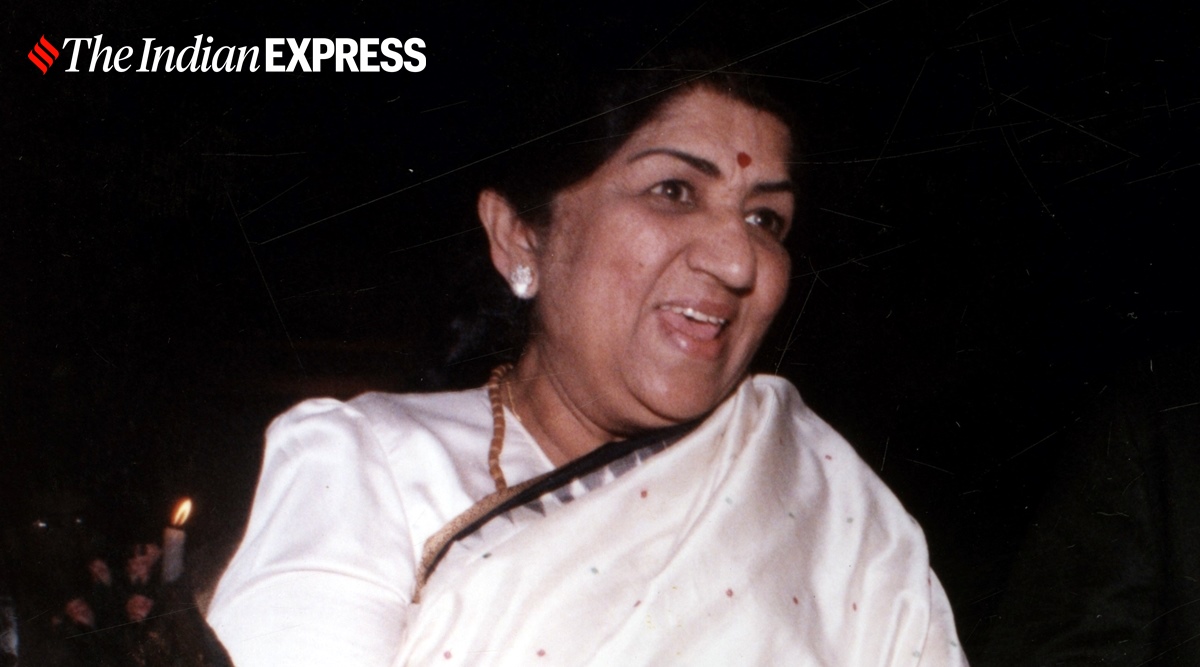 Lata Mangeshkar passed away on February 6, 2022. (Photo: Express Archives)
Lata Mangeshkar passed away on February 6, 2022. (Photo: Express Archives)
Khayyam also once said about her, “She learns the tune so intently that she almost absorbs every note. She instinctively understands what the composer wants from her and executes it to perfection. She always tries to make sure that she is doing full justice to the tune- it doesn’t matter whether the composer is new or established. Most of our songs needed just one or two rehearsals and were recorded in single takes. That’s what makes her a great singer or should I say the greatest, for the adjective ‘great’ seems so inadequate to describe her.”
Lata never compromised on her work, even if that meant being tagged unprofessional by composers. She once said, “Maine kabhi din raat riyaaz nahi kiya (I never trained day and night). But, I also never compromised with my work because I don’t want to hear from millions of people, ‘ab vo baat nahi hai’. This is why I am a bit infamous for being unprofessional. I don’t go for recordings when I am sick. I tell them, ‘Main beemar hun aaj main nahi gaaungi’ but then people get upset with me for not showing up on time.”
But, she fell prey to hatred as she got poisoned in 1962. She told Nasreen Munni Kabir, “In 1962, I fell very ill for about three months. One day, I woke up feeling very uneasy in my stomach. And then I started throwing up – it was terrible, the vomit was a greenish colour. The doctor came and even brought an X-ray machine home because I could not move. He x-rayed my stomach and said I was being slowly poisoned.” Though the singer suspected one of her cooks to be behind the malice, she never got to know about the person who tried to poison her.
In her tough times when she was recovering, noted lyricist Majrooh Sultanpuri kept her company. “He (Mahrooh) ate whatever I ate and recited poetry and read me stories. We talked and laughed together. I thoroughly enjoyed his company,” she shared with Nasreen.
Though there were link-up rumours (she was linked with the late Rajsingh of Dungarpur, with whom she shared an avid interest in cricket. He would accompany her on world tours), Lata never got married and had no qualms about it either, since she ‘always had her family with her’ and she never felt ‘lonely’. Even when asked about the special one in her life, she told Hindustan Times, “There are some things only for the heart to know. Let me keep it that way.”
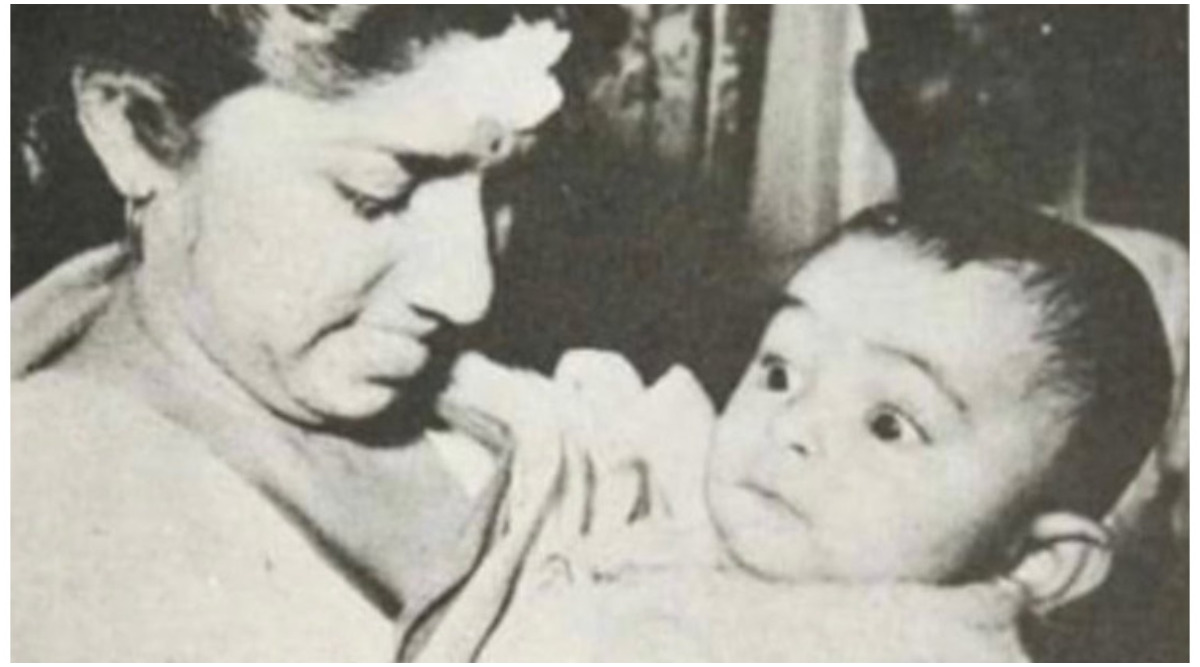 Lata Mangeshkar is seen cradling a baby Rishi Kapoor. (Photo: Neetu Kapoor/Instagram)
Lata Mangeshkar is seen cradling a baby Rishi Kapoor. (Photo: Neetu Kapoor/Instagram)
Besides being an institution of music to many, Lata also championed the cause of giving playback singers their due credit. She made the plea for royalty for the playback singers, which till then would go to the producer, composer or even the actor. “Mahal was a hit, but my name did not feature on the album of the film. Those days playback singers didn’t get any mention or credit in films. No one knew who the singers were when they saw the films. I fought to change that. Why can’t we be acknowledged? Raj Kapoor was the first director to add my name to the titles for Barsaat (1949). That’s how I got my first credit as a singer,” she told The Times of India.
But in her battle for royalty, she fought with Mohammed Rafi as he refused to join her. Angry with him, she announced she would no longer sing with him. Rafi, too, declared that he was only so keen to sing with Lata as she was with him, “If Lata is number one, Mohammed Rafi, too, is number one!” However, the two reconciled, but only professionally.
Not just him, Lata also had a cold war with one of her favourite composers SD Burman. Burman once said in his interview, “Who made Lata’s career? We (composers) did. We gave her the songs.”. His comment didn’t go well with the singer and she stopped talking to him. They broke the ice with the Bandini song ‘Mora Gora Ang Layee Le’.
Lata Mangeshkar, the Nightingale of India, the Queen of Melody, had an illustrious career and life. It is not easy to sum up her life in words. If she was popular for her Bollywood music, she was also known for her ghazals, bhajans, khayals, and devotionals. She recorded her last song ‘Saugandh Mujhe Is Mitti Ki’, which was composed by Mayuresh Pai, as a tribute to the Indian Army and nation. It was released on March 30, 2019. The singer passed away in 2022 after suffering from Covid-19 and pneumonia.
Though the golden voice is missed dearly by music lovers and many wish for her to return, Lata herself never wanted to be reborn, let alone as Lata Mangeshkar. “I don’t want to be a Lata Mangeshkar again. I would request God not to send me on Earth again,” she once said.
- 01
- 02
- 03
- 04
- 05

































